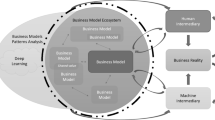Abstract
Future wireless technologies are reshaping the cities from the original to an integrated physical, digital and virtual smart city. The inherent and forthcoming challenge is to high-grade people’s way of living in cities in this context. The idea of digitalization and urbanization is inaugurating an innovative horizon for sustainable infrastructure and stable economic development for the global cities. Global cities digitalization is however putting some new humane and business questions, and dilemmas concerning privacy, safety, health and security on the agenda. There is in this context a need for a clearer vision at the global level for the development of smart cities related to sustainable business, business modelling and competition throughout the different smart cities business model ecosystems. This address a real challenge, but also great potential of increasing urbanization to experience shared accomplishment and exterminate poverty. The critical barrier here is to find a collective negotiation among stakeholders, local population and business associations for developing transparency in policies, communication, mutual partnerships and business modelling. The paper address these challenges and potentials in the context of future wireless technologies bridged to multi business model innovation and business model ecosystems.
















Similar content being viewed by others
References
“World Urbanization Prospects” United Nations. (2014). https://esa.un.org/unpd/wup/publications/files/wup2014-highlights.pdf.
Stanford Peace Innovation Lab. (2019). https://peaceinnovation.stanford.edu/.
The Guardian. (2018). https://www.theguardian.com/uk-news/2018/may/15/met-figures-reveal-deeply-troubling-rise-in-serious-in-london.
IERC. (2019). http://www.ierc.ie/.
Alee, V. (2009). https://www.youtube.com/watch?v=VC7W8cMiVFo.
Lindgren, P. (2018). The multi business model innovation approach part 1. Delft: River Publishers. https://doi.org/10.13052/rp-9788793609655. ISBN 978-87-93609-66-2.
Lindgren, P., Valter, P., & Prasad, R. (2019). Advanced business model innovation supported by artificial intelligence, deep learning, multi business model patterns and a multi business model library. Wireless Personal Communications,107(4), 2263.
Vermesan, O., Eisenhauer, M., Sundmaeker, H., Guillemin, P., Serrano, M., Tragos, E. Z., Vali, J., van der Wees, A., Gluhak, A., & Bahr, R. (2018). Internet of things cognitive transformation technology research trends and applications. Available from: https://www.researchgate.net/publication/318348856_3_Internet_of_Things_Cognitive_Transformation_Technology_Research_Trends_and_Applications.
Vendasta. (2020). http://customerthink.com/7-important-steps-to-understanding-your-customers-journey/.
Christensen, C., Raynor, M. E., & McDonald, R. (2015). What is disruptive innovation? Harward Business Review. https://hbr.org/2015/12/what-is-disruptive-innovation.
Bradbury, D. (2014). Coindeks. https://www.coindesk.com/cryptocurrency-change-sharing-economy.
Berlingske Newspaper. (2020). https://www.berlingske.dk/virksomheder/banker-faar-kloe-af-sommerens-markedsuro-minusrenter-truer-hele.
Porter, M. E. (1985). Competitive advantage. New York: Free Press. ISBN 978-0-684-84146-5.
Yang, C. (2015). The integrated model of core competence and core capability. Total Quality Management,26, 173–189. https://doi.org/10.1080/14783363.2013.820024.
Fogg, B. J. (2003). Persuasive technology: Using computers to change what we think and do., The Morgan Kaufmann series in interactive technologies Amsterdam, Boston: Morgan Kaufmann Publishers.
Lindgren, P., Søndergaard, M. K., Nelson, M., & Fogg, B. J. (2013). Persuasive business models. Journal of Multi Business Model Innovation and Technology,1, 70–98.
Lindgren, P. (2018). Disruptive, radical and incremental multi business model innovation. In Conference: 2018 global wireless summit (GWS). https://doi.org/10.1109/gws.2018.8686679.
https://www.drivkraftdanmark.dk/wp-content/uploads/2019/05/DD_Energistatistik_2019_WEB-spreads.pdf
Author information
Authors and Affiliations
Corresponding author
Additional information
Publisher's Note
Springer Nature remains neutral with regard to jurisdictional claims in published maps and institutional affiliations.
Rights and permissions
About this article
Cite this article
Lindgren, P. Multi Business Model Innovation in a World of Smart Cities with Future Wireless Technologies. Wireless Pers Commun 113, 1423–1435 (2020). https://doi.org/10.1007/s11277-020-07314-1
Published:
Issue Date:
DOI: https://doi.org/10.1007/s11277-020-07314-1




